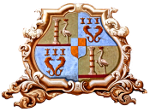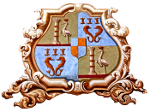The “Chiosi” and the entrance to the Villa.

Villa Dosi Delfini is situated a few hundred metres from the historical centre of Pontremoli (MS), inside the “Chiosi” estate, along the course of the Verde stream. It can be reached by a pleasant walk at the end of a charming path framed by colourful prunus and lagerstroemia trees, which ends with a stone bridge built in 1705, just as the access to the villa, crowned by an elegant chapel.
Passing through the entrance gate, we stop to admire the two monumental cedars of Lebanon, planted in 1863 on the occasion of the birth of the great-grandfather of the current owner, which now partially obscure the façade of the villa.
In front of the sober and harmonious façade, whose colours recall those of the Renaissance Medici villas, we climb the double staircase leading to the main floor and reach the entrance to the drawing room through a stone portal adorned with the busts of the brothers Carlo and Francesco Dosi (nicknamed “i Parrucconi”) and the family coat of arms.
The Great Hall
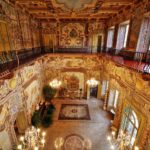
The great two-storey hall, surrounded by an elegant wrought-iron gallery, is virtually the heart of the building: impressive pictorial decoration fills all the surfaces with squares, perspective breakthroughs, allegorical scenes and sumptuous decorations.
The frescoes, painted around 1700 by Francesco Natali and Alessandro Gherardini, completely cover the large room with two naves: On the walls, among the countless painted architectural elements that extend and transform the perception of space, we can still see the figures of the Three Fates, the head of a poet crowned with laurel, some allegorical figures, the Virgin Mary on her throne, and in front of them a fresco depicting the patriarch protecting his descendants from war and misery, with a beautiful dove of peace flying above, and a cornucopia symbolising abundance to complete the picture.
Natali’s Quadrature became the stylistic hallmark of Pontremoli Baroque during the first half of the 18th century.
Inside the hall we can also see a characteristic lounge chair and an extraordinary 18th century console table by the famous Bellunese woodcarver Andrea Brustolon, who has been called the “Michelangelo of wood”. Recently, however, this attribution has been called into question: we invite you to visit the link “The famous Brustolon” at the beginning of the website.
Next to the console table is a portrait of Giulia Reghini, Carlo Dosi’s wife, after whose death in 1712 the lord of the house gradually lost interest and retired to a semi-monastic life.
The Noble Floor Rooms
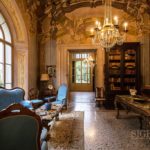
Surrounding the salon are nine reception rooms, all frescoed and decorated with furniture, paintings and chandeliers from the family collection: the Red Parlour, the Billiard Room, the Library, the private family chapel, the Dining Room, the 19th century salon and the bedrooms.
Every room and every object tells us stories and curiosities of a refined and cultivated world, where attention to detail was taken and where everything was carefully designed to amaze and delight the family’s guests.
The Red Parlour
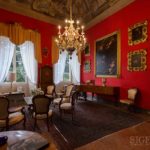
In the small living room, the family would gather to play and listen to the precious harpsichord, placed under a beautiful painting dedicated to Saint Joseph the Carpenter. In the room there are several works of Neapolitan origin, not only paintings but also furniture. The German porcelain chandelier is of rare beauty.
The walls are decorated with portraits of the Farnese dukes who visited the villa in 1714.
The Billiard Room
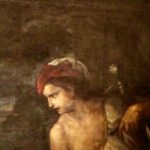
The Neapolitan paintings on the sides represent David with the head of Goliath and a dying Seneca. The presence of numerous paintings of the Neapolitan school is due to the fact that Giovanbattista Natali (son of that Francesco who, together with Gherardini, whose paintings we will find later in the Villa), after working in Pontremoli, settled in Naples, where he remained in contact with the Dosi family, who commissioned him to paint the paintings that were then in vogue. In the centre and on either side of the room, portraits of four generations of Dosi are displayed in chronological order. It is interesting to note the marked change from one generation to the next, reflected in the clothing, from the strict observance of the Counter-Reformation dictates of the 17th century to the mock Roman armour of the mid-18th century. The declining economic fortunes of the last quarter of the 18th century apparently suggested that no further portraits should be made.
The Library
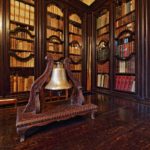
In the first room you can admire the recently unearthed frescoes and the rich library, which is divided into several rooms.
The rich library, divided into several rooms on the main and upper floors, contains thousands of volumes, including manuals, first editions and ancient documents, many of which have yet to be studied. A testimony to the cultural and literary interests of the Dosi family, knowledgeable patrons and collectors.
The Private Chapel
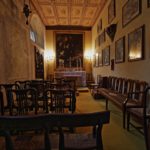
Inside the villa there is a small chapel for private functions. The decoration includes recently restored frescoes and a series of fine 18th century prints.
The Dining Room
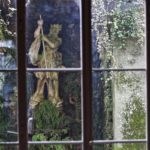
The dining room is in perfect perspective with the salon, the avenue, the bridge with the small chapel and the nymphaeum with the statue of the god Neptune behind it. This axis of perspective intersects with the row of doors in the adjoining rooms. The aquatic theme of the courtyard is repeated in the interior, with monochrome paintings depicting the four rivers.
The Nineteenth-century Salon
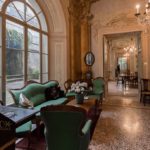
In the nineteenth-century salon, the frescoes by Natali were covered with false wallpaper decorations. There is an interesting portrait of Andrea Ranzi, a Pisan doctor and patriot who distinguished himself in the battle of Curtatone and Montanara. His daughter Teresa married Gian Carlo Dosi, to whom we owe the large Lebanon cedars planted in front of the villa.
The Bedrooms
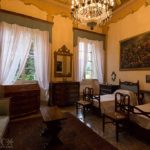
The bedrooms are decorated with prestigious paintings of the Neapolitan school, including a beautiful painting of the Death of St Joseph and other paintings by Gherardini, the author of the present frescoes.
In the second room, in addition to the paintings of the Piacenza school, there is a unique collection of about 200 porcelain birds from various manufacturers (Meissen, Nymphenburg, Herend, Royal Copenhagen, Rosenthal and others).
